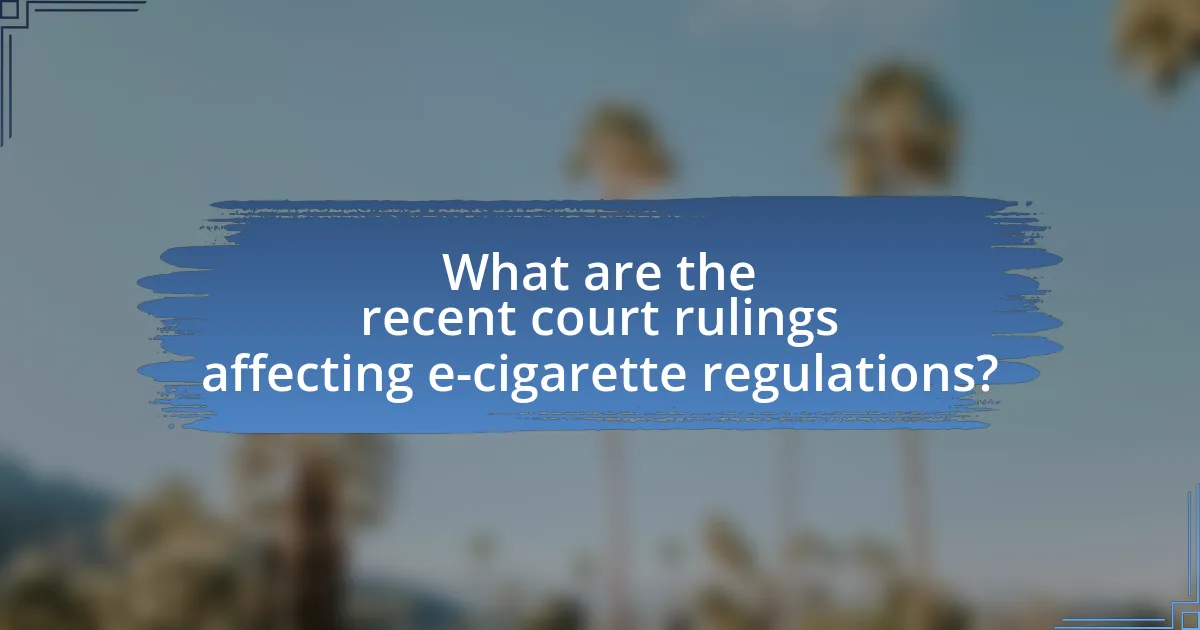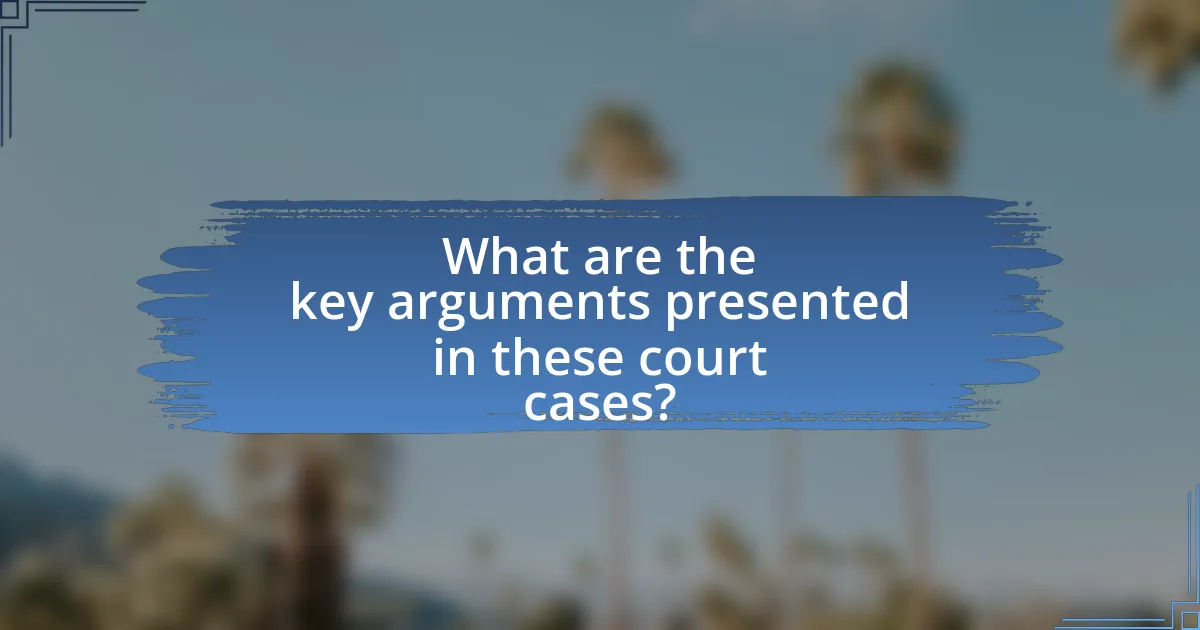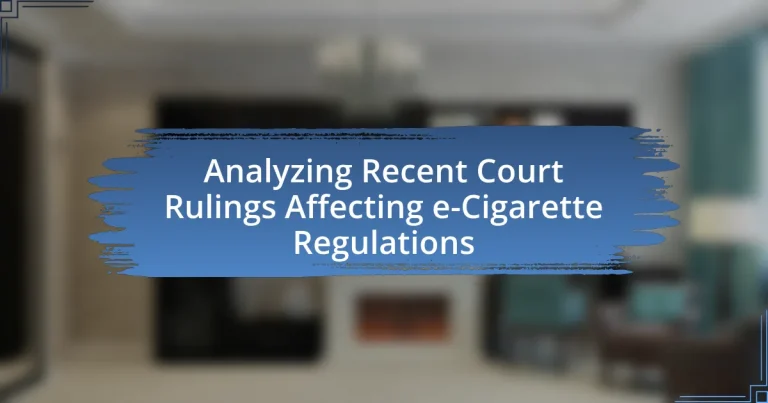The article analyzes recent court rulings that have significantly influenced e-cigarette regulations in the United States. Key developments include a federal court’s affirmation of the FDA’s authority to regulate e-cigarettes, requiring manufacturers to undergo premarket reviews, and state-level rulings supporting local bans on flavored e-cigarettes to protect youth from nicotine addiction. The article discusses the implications of these rulings on the legal landscape for e-cigarettes, the impact on manufacturers and retailers, and the broader public health policy considerations. It also examines the constitutional issues raised, stakeholder responses, and potential future trends in e-cigarette regulation.

What are the recent court rulings affecting e-cigarette regulations?
Recent court rulings have significantly impacted e-cigarette regulations, particularly in the United States. For instance, a federal court ruling in 2023 upheld the Food and Drug Administration’s (FDA) authority to regulate e-cigarettes, affirming that manufacturers must submit products for premarket review to ensure safety and compliance with public health standards. This ruling followed a series of legal challenges from e-cigarette companies contesting the FDA’s stringent regulatory framework. Additionally, various state courts have ruled in favor of local bans on flavored e-cigarettes, citing public health concerns and the need to protect youth from nicotine addiction. These decisions collectively reinforce the regulatory landscape surrounding e-cigarettes, emphasizing the balance between industry interests and public health priorities.
How have these rulings changed the legal landscape for e-cigarettes?
Recent court rulings have significantly altered the legal landscape for e-cigarettes by imposing stricter regulations and clarifying the legal status of these products. For instance, rulings have led to increased scrutiny of e-cigarette marketing practices, particularly concerning claims about health benefits and targeting minors. Additionally, some courts have upheld state-level bans on flavored e-cigarettes, reinforcing the authority of local governments to regulate these products more rigorously. These changes reflect a growing concern over public health and the need for comprehensive regulation in response to the rising popularity of e-cigarettes among youth.
What specific regulations have been impacted by these court decisions?
The specific regulations impacted by recent court decisions include the Food and Drug Administration’s (FDA) authority to regulate e-cigarettes under the Tobacco Control Act. These rulings have challenged the FDA’s premarket review process for e-cigarette products, leading to delays in enforcement actions against non-compliant products. Additionally, state-level regulations concerning age restrictions and marketing practices have also been affected, as courts have ruled on the legality of certain state laws in light of federal regulations. These changes highlight the ongoing legal complexities surrounding e-cigarette regulation and enforcement.
How do these changes affect manufacturers and retailers of e-cigarettes?
Recent court rulings affecting e-cigarette regulations impose stricter compliance requirements on manufacturers and retailers, leading to increased operational costs and potential market restrictions. Manufacturers must adapt to new labeling, marketing, and product approval standards, which can delay product launches and increase expenses. Retailers face challenges in inventory management and may need to limit product offerings to comply with regulations. For instance, the FDA’s enforcement actions have resulted in significant fines and product recalls, highlighting the financial risks associated with non-compliance. These changes ultimately reshape the competitive landscape, as companies that can efficiently navigate the regulatory environment may gain a market advantage.
Why are these court rulings significant for public health policy?
These court rulings are significant for public health policy because they establish legal precedents that shape the regulatory landscape for e-cigarettes, impacting public health outcomes. By affirming or overturning regulations, these rulings influence how e-cigarettes are marketed, sold, and used, which directly affects smoking rates and related health issues. For instance, a ruling that upholds strict advertising restrictions can reduce youth exposure to vaping products, thereby potentially decreasing nicotine addiction among adolescents. Additionally, these decisions can guide future legislative actions, ensuring that public health considerations remain central in the regulation of tobacco products.
What implications do these rulings have for youth access to e-cigarettes?
Recent court rulings have significant implications for youth access to e-cigarettes by potentially tightening regulations and enforcement measures. These rulings may lead to stricter age verification processes and increased penalties for retailers who sell e-cigarettes to minors, thereby reducing the availability of these products to youth. For instance, rulings that uphold state laws banning flavored e-cigarettes, which are particularly appealing to younger users, can further limit youth access. Additionally, the legal precedent set by these rulings may encourage more states to implement similar restrictions, contributing to a broader national trend aimed at protecting youth from nicotine addiction.
How might these decisions influence future public health initiatives?
Recent court rulings affecting e-cigarette regulations may significantly influence future public health initiatives by shaping the legal framework governing tobacco products. These decisions can lead to stricter regulations on e-cigarettes, which may reduce youth access and usage, thereby improving public health outcomes. For instance, rulings that uphold bans on flavored e-cigarettes can decrease their appeal to younger demographics, as evidenced by studies showing that flavors are a primary reason for youth vaping. Consequently, public health initiatives may increasingly focus on comprehensive tobacco control strategies that include e-cigarettes, aligning with the World Health Organization’s Framework Convention on Tobacco Control, which emphasizes the need for evidence-based policies to protect public health.

What are the key arguments presented in these court cases?
The key arguments presented in recent court cases affecting e-cigarette regulations include the balance between public health concerns and individual rights, the interpretation of regulatory authority, and the impact of marketing practices on youth. Courts have examined whether regulations infringe on personal freedoms while also considering the necessity of protecting minors from potential harm associated with e-cigarette use. Additionally, the legal authority of agencies like the FDA to impose restrictions on e-cigarettes has been challenged, with arguments focusing on the adequacy of existing laws to address emerging products. These arguments reflect ongoing debates about the role of government in regulating new technologies in the interest of public health.
What legal precedents are being cited in these rulings?
The legal precedents being cited in these rulings include the Family Smoking Prevention and Tobacco Control Act, which grants the FDA authority to regulate tobacco products, and the Supreme Court case FDA v. Brown & Williamson Tobacco Corp., which established limits on the FDA’s regulatory power over tobacco. These precedents are referenced to support arguments regarding the extent of regulatory authority and the implications for public health policy related to e-cigarettes.
How do these precedents relate to previous tobacco regulation cases?
Recent court rulings regarding e-cigarette regulations build upon established precedents in tobacco regulation cases by reinforcing the legal framework for public health and consumer protection. For instance, the U.S. Supreme Court’s decision in FDA v. Brown & Williamson Tobacco Corp. (2000) established that the FDA could regulate tobacco products to protect public health, which set a precedent for subsequent rulings that address the regulation of newer products like e-cigarettes. These precedents emphasize the government’s authority to impose restrictions on marketing and sales to minors, as seen in cases like United States v. Philip Morris USA Inc. (2006), where the court upheld the government’s right to regulate advertising practices. Thus, recent rulings on e-cigarettes are directly influenced by the legal principles established in earlier tobacco regulation cases, ensuring that public health considerations remain central to regulatory efforts.
What constitutional issues are raised in these court decisions?
The constitutional issues raised in recent court decisions regarding e-cigarette regulations primarily involve the First Amendment and the Commerce Clause. The First Amendment is implicated as courts evaluate whether restrictions on advertising and marketing e-cigarettes infringe upon free speech rights. Additionally, the Commerce Clause is examined in relation to state regulations that may conflict with federal laws governing interstate commerce, particularly concerning the regulation of e-cigarettes as tobacco products. These issues highlight the tension between public health interests and constitutional protections.
How do stakeholders respond to these court rulings?
Stakeholders respond to court rulings on e-cigarette regulations with a mix of support, opposition, and adaptation strategies. For instance, public health advocates often endorse stricter regulations aimed at reducing youth access to e-cigarettes, citing studies that link vaping to increased nicotine addiction among adolescents. Conversely, e-cigarette manufacturers typically challenge these rulings, arguing that they stifle innovation and harm their business interests, as evidenced by legal actions taken against regulatory bodies in various jurisdictions. Retailers may adjust their sales strategies to comply with new regulations while lobbying for more favorable terms, reflecting their vested interest in maintaining market access.
What are the reactions from public health advocates?
Public health advocates have expressed significant concern regarding recent court rulings that affect e-cigarette regulations. They argue that these rulings may undermine efforts to control youth vaping and protect public health. For instance, advocates highlight that the courts’ decisions could lead to increased availability of flavored e-cigarettes, which are particularly appealing to minors, thereby exacerbating the youth vaping epidemic. Research from the National Institute on Drug Abuse indicates that flavored products are a primary reason for youth initiation into vaping. Consequently, public health advocates are calling for stricter regulations to mitigate these risks and safeguard community health.
How are e-cigarette companies reacting to these legal changes?
E-cigarette companies are adapting to legal changes by increasing compliance efforts and modifying product offerings. Many companies are reformulating their products to meet new regulatory standards, such as reducing nicotine levels or altering flavor profiles to align with restrictions. For instance, following recent court rulings that limit certain marketing practices, companies have shifted their advertising strategies to focus on harm reduction and adult smoking cessation. Additionally, some firms are investing in legal resources to navigate the evolving regulatory landscape, ensuring they remain compliant while advocating for favorable regulations. This proactive approach is evident in the industry’s response to the FDA’s intensified scrutiny and state-level regulations, which have prompted companies to enhance transparency and engage in dialogue with regulators.

What are the potential future implications of these rulings?
The potential future implications of recent court rulings affecting e-cigarette regulations include increased market access for manufacturers and potential changes in public health outcomes. These rulings may lead to a more favorable regulatory environment, allowing e-cigarette companies to introduce new products without extensive pre-market approval processes. For instance, if courts limit the authority of regulatory bodies like the FDA, it could result in fewer restrictions on marketing and sales, thereby expanding consumer access. Additionally, these rulings could influence public health by either promoting harm reduction through safer alternatives to smoking or, conversely, increasing youth access to nicotine products, which could exacerbate public health concerns. Historical data shows that regulatory changes can significantly impact market dynamics and public health trends, as seen in the tobacco industry following various legal challenges.
How might these court decisions shape future e-cigarette legislation?
Court decisions regarding e-cigarette regulations may lead to stricter legislative frameworks in the future. For instance, rulings that uphold bans on flavored e-cigarettes or impose stricter marketing restrictions can set precedents that encourage lawmakers to adopt similar measures. Additionally, if courts validate the authority of regulatory bodies like the FDA to enforce stringent guidelines, this could empower future legislation aimed at reducing youth access and promoting public health. Historical examples, such as the 2020 court ruling that upheld the FDA’s authority to regulate e-cigarettes, illustrate how judicial outcomes can influence legislative approaches and public policy in the realm of tobacco control.
What trends can we expect in e-cigarette regulation moving forward?
E-cigarette regulation is expected to trend towards stricter controls and increased oversight in response to public health concerns. Recent court rulings have highlighted the need for comprehensive regulatory frameworks that address issues such as marketing practices, age restrictions, and product safety standards. For instance, the U.S. Food and Drug Administration (FDA) has been empowered to enforce regulations that limit the sale of flavored e-cigarettes, which are particularly appealing to youth, reflecting a growing emphasis on protecting younger populations from nicotine addiction. Additionally, states are increasingly implementing their own regulations, which may include higher taxes on e-cigarettes and bans on certain products, further indicating a shift towards more stringent regulatory measures.
How could these rulings influence international e-cigarette policies?
Recent court rulings could significantly influence international e-cigarette policies by setting legal precedents that other countries may adopt. For instance, rulings that uphold strict regulations on e-cigarettes can encourage nations to implement similar measures to protect public health, as seen in jurisdictions where courts have favored stringent controls. Additionally, these rulings may prompt international organizations, such as the World Health Organization, to advocate for unified regulatory frameworks, thereby shaping global standards for e-cigarette use and marketing. The alignment of policies across countries can lead to a more cohesive approach to addressing health concerns associated with e-cigarettes, as evidenced by the increasing trend of nations revising their tobacco control laws in response to emerging evidence and legal outcomes.
What best practices should stakeholders consider in light of these rulings?
Stakeholders should prioritize compliance with updated e-cigarette regulations to mitigate legal risks. This includes conducting thorough reviews of product formulations and marketing practices to ensure alignment with the latest court rulings. Additionally, stakeholders should implement robust training programs for employees on regulatory requirements and best practices. Engaging with legal experts to interpret rulings and adapt business strategies accordingly is also essential. Furthermore, stakeholders should actively participate in industry advocacy to influence future regulations and maintain open communication with regulatory bodies. These practices are crucial for maintaining operational integrity and protecting market position in a rapidly evolving regulatory landscape.
How can manufacturers ensure compliance with new regulations?
Manufacturers can ensure compliance with new regulations by implementing robust quality management systems and staying informed about regulatory changes. These systems should include regular audits, employee training on compliance standards, and the integration of compliance checks into the production process. For instance, the FDA requires e-cigarette manufacturers to submit premarket tobacco product applications (PMTAs) to demonstrate that their products meet public health standards. By adhering to these requirements and continuously monitoring regulatory updates, manufacturers can effectively align their practices with legal expectations.
What strategies can public health officials adopt to address the implications of these rulings?
Public health officials can adopt several strategies to address the implications of recent court rulings affecting e-cigarette regulations. First, they can enhance public education campaigns to inform the community about the health risks associated with e-cigarette use, particularly among youth, as studies indicate that e-cigarettes can lead to nicotine addiction and other health issues. Second, officials can advocate for stronger regulatory frameworks at the state and federal levels to close loopholes created by court rulings, ensuring that e-cigarette products are subject to the same stringent regulations as traditional tobacco products. Third, collaboration with local governments and community organizations can facilitate the development of targeted interventions aimed at reducing e-cigarette use among vulnerable populations. Finally, public health officials can engage in ongoing research to monitor the impact of these rulings on public health outcomes, allowing for data-driven adjustments to strategies as needed.
